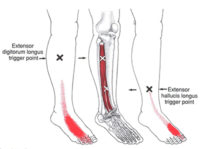Hammer Toe Muscles…

Hammer toes and foot pain are caused by trigger points in the long toe extensors (extensor digitorum longus and flexor hallucis longus). You may not be bothered by your hammer toes but they are an important symptom of imbalance for a skilled myofascial therapist.
Although these toes look pretty good, you may also feel pain from these muscles on the top of the foot and extending into the top of the toes. In addition, some people with trigger points in these muscles experience night cramps in their calves. In children, these can be experienced as growing pains.
If we have myofascial dysfunction in these long toe extensors, it can impact our foot mechanics, our ability to adapt to the ground as we walk, or plant our foot in sports activities. If you are a dancer, gymnast, aerialist or other similar performer, shortened toes extensors will limit your ability to point your toes. Why haven’t we heard about these muscles?
Hammer Toes and Foot Pain
If you are developing hammer toes, that is another indication that you may have trigger points in your long toe extensors. Read more... First, in the classic hammer toe, the first joint of your toe is extended (where it meets your foot), the second joint is flexed and the farthest joint is also extended. There are variations on the hammer toe. But, if you have a claw toe the first joint is extended and the next two are flexed. If you have a mallet toe, only the farthest joint at the tip is flexed. This happens because you develop muscle imbalances while compensating for other problems.
Extensor Subsitution and Hammer Toes
This means your long toe extensors are contracting during the swing phase of your gait. Read more... But, these long toes flexors have a big mechanical advantage over the small lumbrical muscles in the feet. Your toes are hyperextended during the swing phase and heelstrike. In addition, as the condition progresses, they may remain that way, even when weight bearing. Your long toe extensors do this because they are trying to provide more than their normal effort in dorsiflexion. But if this is unopposed by weak lumbricals, your extended toes keep occuring with every step. Anything that increases plantar flexion can cause a vicious cycle. For many of us, this actually starts with a response to taut bands or trigger points in our long toe flexors! Wearing shoes too much, especially in childhood, may also contribute to disuse atrophy of your lumbricals. Hammer toes and foot pain can often be corrected without surgery or invasive procedures if treated early. You can find more information on the anatomy and function of the long toes extensors is in the Extras section at the end of this article.
Most often, you might activate trigger points in the long toe extensors by tripping or falling.
In addition, excessive running can do it. Or catching the ground when kicking a ball…or walking in sand or on uneven ground that you not used to can also do it. It can be similar to turf toe.
If your ankle is immobilized after a fracture or sprain that can activate these trigger points.
Wearing high heels causes trigger point activations by keeping your long toe extensors stretched throughout the day. This makes them work harder. They easily become overloaded and develop taut bands and trigger points.
Keeping your foot in plantar flexion, as with your right foot when driving, will lead to other troubles. The shortening of your soleus and gastroc reduce dorsiflexion. This can chronically overload the toe extensors. You may encounter a similar mechanism if you tuck your feet under your chair or if they do not reach the ground.
Finally, if you have experienced spinal issues at the L4-L5 level or anterior compartment syndrome you can also develop trigger points in the long toe extensors.
Myofascial Treatment of Hammer Toes and Foot Pain
Self Compressions
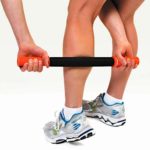 A roller like the Tiger Tail is helpful to warm up the muscles. First, gently roll the entire lower leg, aiming to increase circulation and warm the muscles up. Then, gradually increase pressure. Continuing, begin to work a little deeper, searching for tender areas and trigger points. Move more closely to the toe extensor trigger points about 1/3 and 2/3 of the way up the front of the shin. These muscles are very deep and quite thin. You may struggle a bit to find them.
A roller like the Tiger Tail is helpful to warm up the muscles. First, gently roll the entire lower leg, aiming to increase circulation and warm the muscles up. Then, gradually increase pressure. Continuing, begin to work a little deeper, searching for tender areas and trigger points. Move more closely to the toe extensor trigger points about 1/3 and 2/3 of the way up the front of the shin. These muscles are very deep and quite thin. You may struggle a bit to find them.
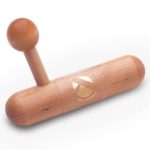 Then, when you feel you have found it, stop rolling and experiment with gently rocking and and wiggling of the roller on this area, while continuing to maintain pressure, until any pain subsides and the muscle releases. If you have trouble with the roller or you need more targeted pressure, consider using something like a Index Knobber.
Then, when you feel you have found it, stop rolling and experiment with gently rocking and and wiggling of the roller on this area, while continuing to maintain pressure, until any pain subsides and the muscle releases. If you have trouble with the roller or you need more targeted pressure, consider using something like a Index Knobber.
Other Techniques
Because these muscles are quite deep it is more difficult to reach with massage techniques than some other muscles in the calf. Therefore, they are not very responsive to kinesio taping, ultrasound or other superficial techniques. However, we easily can target trigger points in these muscles with acoustic compression therapy.
Stretches
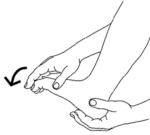 The long toe extensors are quite easy to stretch. Begin seated and gently flex and extend the toes. Next, grasp the toes and gently flex them firmly. Work the big toe separately. For this and the remaining stretches, try this technique: Alternate gently extend against resistance, relax and ‘pick up the slack’. Try this three times, slowly.
The long toe extensors are quite easy to stretch. Begin seated and gently flex and extend the toes. Next, grasp the toes and gently flex them firmly. Work the big toe separately. For this and the remaining stretches, try this technique: Alternate gently extend against resistance, relax and ‘pick up the slack’. Try this three times, slowly.
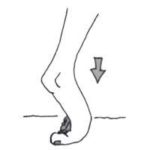 Another way to deepen toe extensor stretches is to use the floor. Be careful and don’t do this too forcefully.
Another way to deepen toe extensor stretches is to use the floor. Be careful and don’t do this too forcefully.
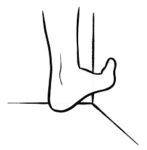 Of course, you should stretch your toe flexors at the same time. They are covered in detail in another post. However, many people experience cramping when stretching the extensors. So, you can fix that with a flexor stretch. So that means that it is usually better to stretch the toe extensors first.
Of course, you should stretch your toe flexors at the same time. They are covered in detail in another post. However, many people experience cramping when stretching the extensors. So, you can fix that with a flexor stretch. So that means that it is usually better to stretch the toe extensors first.
Strengthening
You may benefit from simple strengthening exercises for your toe extensors. Some strength training approaches use calibrated resistance band training. We often find that muscles like the toe extensors themselves aren’t weak, but that some other muscle in their functional unit is. This overloads the long toes extensors.
For instance, weak in the intrinsic muscles of your foot, including the short toe extensors on the top of your foot, can cause the long toe extensors to work to hard. This mechanism can work in either direction. If the long toe extensors are weak, the muscles of the foot (and others) will pay the price.
s
Avoid wearing high heels.
On long drives, you should consider stopping and walking around for 10-15 minutes. This will help overcome the effects of hours of immobilization.
If you are a runner, take a break. This includes treadmills and ellipiticals. Substitute swimming, rowing or cycling for aerobic activity for a while. You may also be working on deconditioned leg and foot muscles during this time.
Next, resume running on an ellipitcal, if possible. This reduces strain on your toes. Finally, you can move up to a treadmill or other flat, level surface. Avoid slanted or uneven surfaces.
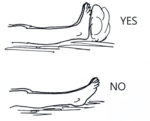 In general, your long toe extensors will feel better if you keep them in a neutral position at night. Try to avoid tight or heavy bed coverings.
In general, your long toe extensors will feel better if you keep them in a neutral position at night. Try to avoid tight or heavy bed coverings.
A pillow or bolster placed at the foot of the bed may help to gently keep the feet in a neutral position. We do not recommend devices that pull, push or fix the feet into a particular position during sleep.
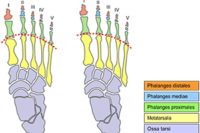 If you have trigger points in the calves we will usually want to check you for Morton's Foot Structure (MFS). This common skeletal variation makes your foot want to pronate. So it makes sense that a muscle whose primary function is to resist pronation would be unhappy.
A simple correction with a posture control insert is usually all that is needed. Less often, the bones in the foot move too much and the arch has fallen. This requires an appropriate arch support that can be added to the posture control insole.
Next, we will probably perform a preliminary screening for differences in leg length. Because of the role of the fibs as lower muscular outrigger, a difference in the length of your legs makes these muscles work harder. Finally, we will also probably screen you to see if the two sides of your pelvis are different sizes.
Unsurprisingly, if you have a combination of these structural variations, they will compound each other. Fortunately, we can easily correct all three conditions. This makes other treatments much more effective.
If you have trigger points in the calves we will usually want to check you for Morton's Foot Structure (MFS). This common skeletal variation makes your foot want to pronate. So it makes sense that a muscle whose primary function is to resist pronation would be unhappy.
A simple correction with a posture control insert is usually all that is needed. Less often, the bones in the foot move too much and the arch has fallen. This requires an appropriate arch support that can be added to the posture control insole.
Next, we will probably perform a preliminary screening for differences in leg length. Because of the role of the fibs as lower muscular outrigger, a difference in the length of your legs makes these muscles work harder. Finally, we will also probably screen you to see if the two sides of your pelvis are different sizes.
Unsurprisingly, if you have a combination of these structural variations, they will compound each other. Fortunately, we can easily correct all three conditions. This makes other treatments much more effective.
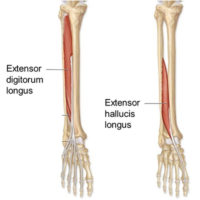 It is helpful to review a little bit of the anatomy to understand how these muscles work. In this illustration the other muscles have been removed for clarity. The long toe extensors are located VERY deep to all of them. Each of muscles attaches to the front of the tibia, the fibula and the tissue in between them and proceeds down toward the foot.
It is helpful to review a little bit of the anatomy to understand how these muscles work. In this illustration the other muscles have been removed for clarity. The long toe extensors are located VERY deep to all of them. Each of muscles attaches to the front of the tibia, the fibula and the tissue in between them and proceeds down toward the foot.
The tendon of the long toes extensor muscle (extensor digitorum longus) attaches to the tips of topside of each of the 2nd-4th toes. This muscle provides most of the power in toe extension.
In addition, we can see that the big toe extensor (extensor hallucis longus) runs straight across the top of the foot and attaches to the tip of th topside of the big toe.
First, the long toes extensor helps with pure dorsiflexion and eversion of your foot balancing the inversion caused by tibialis anterior. It extends the four smaller toes.
The big toe extensor also helps with dorsiflexion but inverts your foot and extends the big toe.
When walking or running, your long toe extensors help in controlling the movement of your foot toward the floor immediately following heel strike. During the swing phase of your gait both muscles provide clearance by also helping to pull up on the foot. In addition, when standing, they help control postural sway to the back.
“The peak activity is just before or during the release/contact with the ball…”
Interestingly, during sports activities involving the upper body, the long toes extensor activates to help fix your foot when throwing, during golf swing, tennis stroke or baseball swing.
If your long toe extensors are chronically engaged due to trigger points you may develop hammer toes and foot pain.

